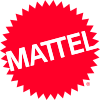Uno (card game)
This article needs additional citations for verification. (December 2013) |
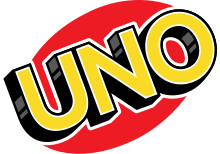 | |
| Type | Shedding-type |
|---|---|
| Players | 2–10 players[1] |
| Skills | Hand management |
| Age range | 7+[1] |
| Cards | 112[2] |
| Playing time | Varies |
| Chance | High |
Uno[discuss] (/ˈuːnoʊ/; from Spanish and Italian for 'one'; stylized as UNO) is an American shedding-type card game that is played with a specially printed deck. The game's general principles put it into the crazy eights family of card games, and it is similar to the traditional European game mau-mau.
It has been a Mattel brand since 1992.[3]
History
The game was originally developed in 1971 by Merle Robbins in Reading, Ohio, a suburb of Cincinnati. When his family and friends began to play more and more, he spent $8,000 to have 5,000 copies of the game made.[4] He sold it from his barbershop at first, and local businesses began to sell it as well. Robbins later sold the rights to Uno to a group of friends headed by Robert Tezak, a funeral parlor owner in Joliet, Illinois, for $50,000 plus royalties of 10 cents per game. Tezak formed International Games, Inc., to market Uno, with offices behind his funeral parlor. The games were produced by Lewis Saltzman of Saltzman Printers in Maywood, Illinois.
In 1992, International Games became part of the Mattel family of companies.[5]
Official rules
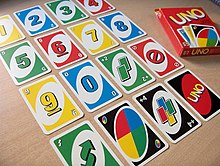

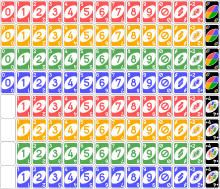
The aim of the game is to be the first player to score 500 points, achieved (usually over several rounds of play) by being the first to play all of one's own cards and scoring points for the cards still held by the other players.
The 2018 edition of the game consists of 112 cards: 25 in each of four color suits (red, yellow, green, blue), each suit consisting of one zero, two each of 1 through 9, and two each of the action cards "Skip", "Draw Two", and "Reverse". The deck also contains four "Wild" cards, four "Wild Draw Four", one "Wild Shuffle Hands" and three "Wild Customizable".[2]
For each hand, a dealer is determined by having each player randomly draw one card from the deck. The player with the highest number card deals, and all cards are reshuffled into the deck to begin the dealing.
To start a hand, seven cards are dealt to each player, and the top card of the remaining deck is flipped over and set aside to begin the discard pile. The player to the dealer's left plays first unless the first card on the discard pile is an action or Wild card (see below). On a player's turn, they must do one of the following:
- play one card matching the discard in color, number, or symbol
- play a Wild card, or a playable Wild Draw Four card (see restriction below)
- draw the top card from the deck, and play it if possible
Cards are played by laying them face-up on top of the discard pile. Play initially proceeds clockwise around the table.
Action or Wild cards have the following effects:
| Card | Effect when played from hand | Effect as first discard |
|---|---|---|
| Skip | Next player in sequence misses a turn | Player to dealer's left misses a turn |
| Reverse | Order of play switches directions (clockwise to counterclockwise, or vice versa) | Dealer plays first; play proceeds counterclockwise |
| Draw Two (+2) | Next player in sequence draws two cards and misses a turn | Player to dealer's left draws two cards and misses a turn |
| Wild | Player declares the next color to be matched (may be used on any turn even if the player has matching color) | Player to dealer's left declares the first color to be matched and takes the first turn |
| Wild Draw Four | Player declares the next color to be matched; next player in sequence draws four cards and misses a turn. May be legally played only if the player has no cards of the current color (see Penalties) | Card is returned to the deck, then a new card is laid down into the discard pile (deck may be reshuffled first if needed) |
- A player who draws a playable card from the deck must either play or keep that card and may play no other card from their hand on that turn.
- A player may play a Wild card at any time, even if that player has other playable cards.
- A player may play a Wild Draw Four card only if that player has no cards matching the current color. The player may have cards of a different color matching the current number or symbol or a Wild card and still play the Wild Draw Four card.[6] A player who plays a Wild Draw Four may be challenged by the next player in sequence (see Penalties) to prove that their hand meets this condition.
- If not otherwise challenged, an illegally played Wild Draw Four stays without penalty for its player.
- When playing a Wild or Wild Draw Four card, a player may declare the current color as the next one to be matched.
- If the draw deck runs out during play, the top discard is set aside and the rest of the pile is shuffled to create a new deck. Play then proceeds normally.
- It is illegal to trade cards of any sort with another player.
A player who plays their penultimate card must call "Uno" as a warning to the other players.[7]
The first player to get rid of their last card ("going out") wins the hand and scores points for the cards held by the other players. Number cards count their face value, all action cards count 20, and Wild and Wild Draw Four cards count 50. If a Draw Two or Wild Draw Four card is played to go out, the next player in the sequence must draw the appropriate number of cards before the score is tallied.
The first player to score 500 points wins the game.
Penalties
- If a player does not call "Uno" after laying down their penultimate card and is caught before the next player in sequence starts to take a turn (i.e., plays a card from their hand, draws from the deck, or touches the discard pile), they must draw two cards as a penalty. If the player is not caught in time or remembers to call "Uno" before being caught, no penalty applies to that player.[6]
- If a player plays a Wild Draw Four card, the next player in turn order may choose to challenge its use. The player who used the Wild Draw Four must privately show their hand to the challenging player in order to demonstrate that they had no prior matching colored cards. If the challenge is successful, then the challenged player must draw four cards instead and play continues with the challenger. Otherwise, the challenger must draw six cards – the four cards they were already required to draw plus two more cards – and lose their turn.[6] In either case, the Wild Draw Four stays with its chosen color.
Two-player game
In a two-player game, the Reverse card acts like a Skip card; when played, the other player misses a turn.[8]
House rules
The following house rules are suggested in the Uno instructions to alter the game:
- Progressive or Stacking Uno: If a draw card is played, and the following player has a card with the same symbol, they can play that card and "stack" the penalty, which adds to the current penalty and passes it to the following player[6] (although a +4 cannot be stacked on a +2, or vice versa).[9] This house rule is so commonly used that there was widespread Twitter surprise in 2019 when Mattel stated that stacking was not part of the standard rules of Uno.[9]
- Seven-O: Every time a "7" is played, the player who played the "7" card must trade their hand with another player of their choice. Every time a "0" is played, all players pass their hands to the next player in the current direction of play.[6]
- Jump-In: If a player has exactly the same card (both number and color) as the top card of the discard pile, they may play it immediately, even if it is not their turn. The game then continues as if that player had just taken their turn.[6]
Card and deck styles
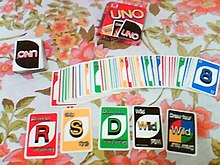
Modern Uno action cards bear symbols which denote their action, except for the Wild cards which still bear the word "Wild". Before the design change,[when?] such cards in English versions of the game had letters only. Earlier English versions can be recognized by the absence of the white rim that surrounds the edge of most Uno cards.
Other versions of the game use symbols and images in both old and new designs, especially ones with Wild cards that do not bear the word "Wild". There are also language-free versions of the newer styles that do not bear the word "Wild" but have the same styling.
The 2010 "Uno Mod" edition uses symbols instead of letters or numbers.
On September 16, 2017, Mattel released Uno ColorAdd, which was designed specifically for those suffering from color blindness.[10]
On October 1, 2019, Mattel released a Braille version of their game with Mark Riccobono, president of the National Federation of the Blind. Riccobono said in a press release, "The fact that a blind person is now able to play a classic game of UNO straight out of the box with both blind and sighted friends or family members is a truly meaningful moment for our community."[11][12]
Special Uno games
- Uno 50th Anniversary (2021)
- Uno All Wild (2022)
- Uno Attack (Uno Extreme in the UK and Canada) (1999)
- Uno Attack Jurassic World (2018)
- Uno Attack Refill Deck
- Uno Bingo (1997)
- Uno Blast (2012)
- Uno Blitzo (2000)
- Uno Choo-Choo (2011)
- Uno Color Screen
- Uno Deluxe
- Uno Dare (2014)
- Uno Dice (1987, 1996, 2011)
- Uno Dominoes (1986)
- Electronic Uno
- Uno Flash (2007)
- Uno Flip (2009) (Target Store Exclusive)
- Uno Flip (2019)
- Giant Uno (2016)
- Giant BTS Uno (2020)
- Uno H2O (2004)
- Uno H2O To Go
- Uno Hearts (1994)
- Uno Junior (1992)
- King Size Uno (1994)
- Uno Madness (1995)
- Uno Moo (2008, 2014)
- Uno Power Grab
- Uno Reflex
- Uno Roboto
- Uno Royal Revenge (2014)
- Uno Rummy Up (1993)
- Uno Spin (2005)
- Uno Spin Hannah Montana (2005)
- Uno Spin One Piece (Japan)
- Uno Spin To Go (2010)
- Uno Stacko (1994)
- Travel Uno Stacko
- Uno Tippo (2009)
- Uno Slam
- Uno Tiki Twist (2014)
- Uno Wild Jackpot (2016)
- Uno Wild Tiles (1982)
- Get Wild for Uno (2016)
- Uno Minecraft (2018)
- Uno Showdown Supercharged (2020)
- Uno Triple Play (2021)
- Uno Go! (2022)
Uno H2O
Uno H2O differs from the standard game in that the cards are transparent waterproof cards, and the presence of some special cards:
| Card Name | Feature |
|---|---|
| Wild Downpour Draw 1 | It has a watermark on it and when a watermark is on the card, it symbolizes that all other players must draw one. The person who plays the card can also choose the color: red, yellow, blue, or green. |
| Wild Downpour Draw 2 |
Video games
- Uno (handheld video game – 2000)
- Uno (handheld video game for the Game Boy Color of the classic Uno board game)
- Uno DX (Japanese exclusive Sega Saturn game by Mitsui & Co. – 1998)
- Uno (PlayStation Network)
- Uno (Xbox Live Arcade)
- Uno Rush (Xbox Live Arcade)
- Uno Challenge (mobile version of the classic Uno board game)
- Uno Free Fall (puzzle game for mobile phones)
- Uno 52 (Nintendo Game Boy Advance)
- Super Uno (Super Famicom)
- Uno (Facebook) (Adobe Flash–based version of the classic Uno card game produced by GameHouse Studios)
- Uno (iPhone) Features online and local play. Produced by Gameloft
- Uno (iPad) The same as on the iPhone, but with enhanced graphics. Produced by Gameloft
- Uno (Android) Released as three versions: SD, HD and Free with adverts. Produced by Gameloft
- Uno (DSi)
- Uno (WiiWare) Produced by Gameloft[13]
- Uno & Friends (various platforms)
- Pocket Uno
- Uno[14] and Uno & Friends[15] for Windows Phone
- Uno Undercover (Windows)
- Uno (2016 video game for PC, PlayStation 4, and Xbox One by Ubisoft)
- Uno – 2017 video game (release of 2016 game on the Nintendo Switch), produced by Ubisoft[16]
- UNO! – developed and published by Mattel163 in 2017
Variations
Many variations from standard gameplay exist, such as Elimination Uno, Speed Uno and Pirate Uno.[17]
In 2018, Mattel released a spin-off of Uno entitled Dos; the game is differentiated primarily by having a "center row" of discard piles, where pairs of cards that add up to the sum of a card on the top of one of the piles may be discarded.[18][19]
The game can be played with two decks of standard playing cards, if the jokers are marked up as the zeroes of the four suits, and the royalty treated as the special cards.
Spin-offs
Uno Slot
In 2002, International Gaming Technology (IGT)[20] released a video slot machine based on Uno.
Uno: The Game Show
In March 2013, it was announced that Mattel and the Gurin Company[21][22] were teaming up to create a game show based on the card game, produced as a half-hour daily strip with a $100,000 cash jackpot along with a primetime version in which contestants competed for 1 million dollars. However, the idea was scrapped later on.
Film adaptation
On February 4, 2021, an action heist comedy film based on the game was announced to be in development for Mattel Films with Lil Yachty of record label Quality Control Music developing and being eyed for the lead role alongside the label's managers Kevin "Coach K" Lee and Pierre "P" Thomas, and Brian Sher for Quality Films producing, Marcy Kelly writing, and Robbie Brenner and Kevin McKeon leading the project as executive producer and supervising producer, respectively.[23]
Similar games
Uno is a member of the shedding family of card games. The shedding family of card games consists of games where the objective is to get rid of all your cards while preventing the other players from getting rid of their cards.
References
- ^ a b Uno instruction sheet, 1983, International Games Ltd.
- ^ a b "Uno Instructions, 2018" (PDF). mattel.com. Retrieved 14 November 2022.
- ^ "Mattel to buy International Games". UPI. Retrieved 29 November 2018.
- ^ "Uno History". Unorules.org.
- ^ "30 Anniversary rule Book" (PDF). Mattel. 2001. Retrieved 9 February 2013.
- ^ a b c d e f "UNO Basic Instructions" (PDF). Mattel. 2008.
- ^ Exact wording of the official rules: "When you play your next-to-last card, you must yell 'UNO' (meaning 'one') to indicate that you have only one card left".
- ^ "Uno Instruction Sheet" (PDF).
- ^ a b Hourigan, Adam. "The Uno rule you're all getting wrong". Daily Examiner. Retrieved 25 September 2019.
- ^ Jacobson, Candice; Lussier, Muriel (16 September 2017). "UNO® Introduces The First Card Game For The Colorblind". news.mattel.com. Mattel Newsroom. Retrieved 2 October 2019.
- ^ Capron, Maddie; Zdanowicz, Christina (1 October 2019). "Mattel releases a braille version of UNO". cnn.com. CNN. Retrieved 2 October 2019.
- ^ Tucker, Devin; Hein, Joanna; Cascone, Stephanie (1 October 2019). "UNO® Introduces First Official Braille Deck". businesswire.com. Business Wire. Retrieved 2 October 2019.
- ^ "Nintendo Life – Uno WiiWare review". Nintendo Life. November 2009. Retrieved 5 March 2019.
- ^ "Buy Uno". Microsoft Store.
- ^ "Buy UNO ™ & Friends". Microsoft Store.
- ^ "UNO Now Available On Nintendo Switch". Gamasutra. 7 November 2017. Retrieved 28 March 2020.
- ^ "Uno Variations".
- ^ Friedman, Megan (13 February 2018). "The Makers of UNO Are Releasing a Spinoff Game Called DOS". Good Housekeeping. Retrieved 28 March 2018.
- ^ Beck, Kellen. "'DOS,' the sequel to 'UNO,' is a new take on an old favorite". Mashable. Retrieved 4 December 2018.
- ^ "UNO Slots" (PDF). Archived from the original (PDF) on 5 March 2004.
- ^ "'UNO: The Game Show' In The Cards From Mattel And Gurin Co". Deadline. 25 March 2013. Retrieved 25 March 2013.
- ^ Lyons, Margaret (26 March 2013). "Who Doesn't Want an UNO TV Show?". Vulture. Retrieved 26 March 2013.
- ^ "Lil Yachty Developing Action Heist Movie Based on Card Game Uno". Variety. 4 February 2021. Retrieved 4 February 2021.
Bibliography
- Current official rules, from Mattel
- Official Mattel Uno site
- Uno Rules at UnoRules.org
- Uno Variations at UnoVariations.com
- Uno variants at pagat.com
- Uno News at Wonkavator
- Uno at BoardGameGeek

